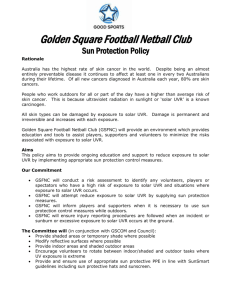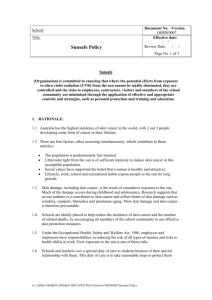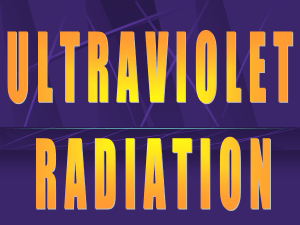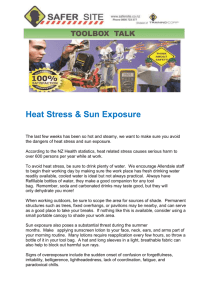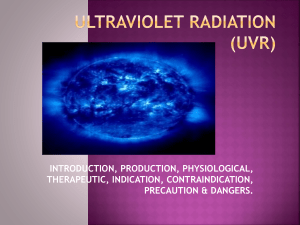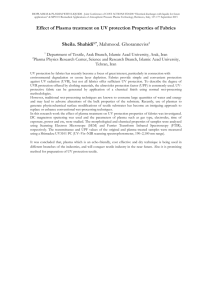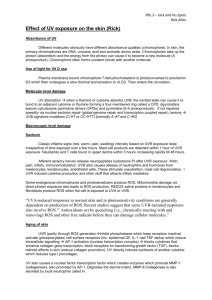Influence of UV Radiation on Immunological System and
advertisement
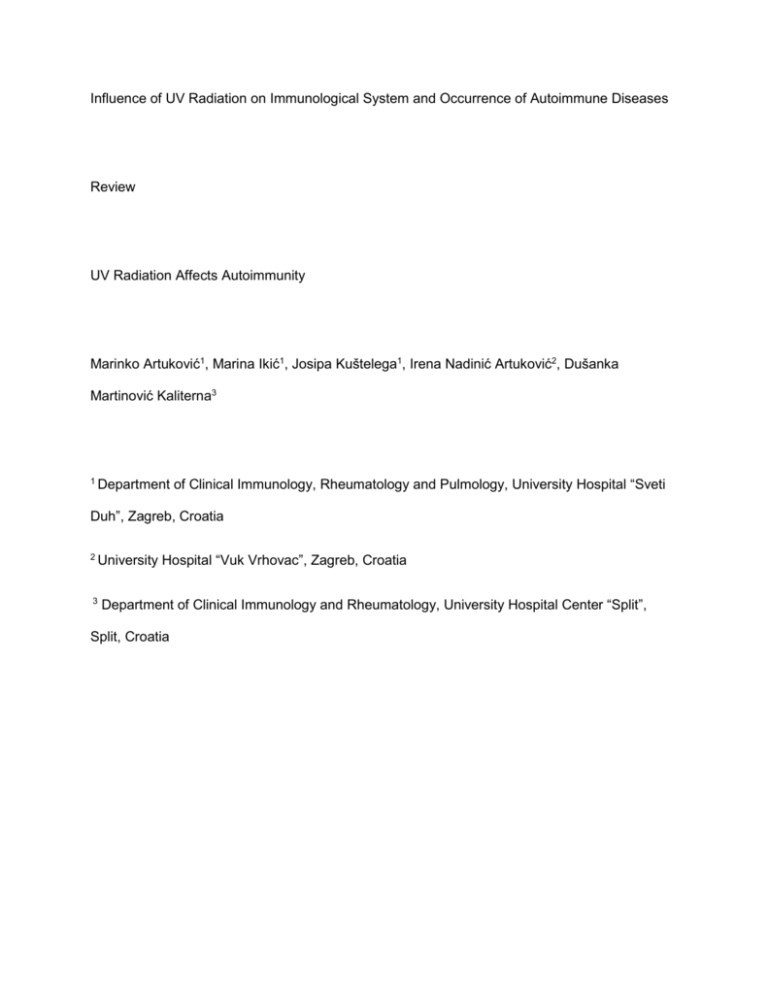
Influence of UV Radiation on Immunological System and Occurrence of Autoimmune Diseases Review UV Radiation Affects Autoimmunity Marinko Artuković1, Marina Ikić1, Josipa Kuštelega1, Irena Nadinić Artuković2, Dušanka Martinović Kaliterna3 1 Department of Clinical Immunology, Rheumatology and Pulmology, University Hospital “Sveti Duh”, Zagreb, Croatia 2 University Hospital “Vuk Vrhovac”, Zagreb, Croatia 3 Department of Clinical Immunology and Rheumatology, University Hospital Center “Split”, Split, Croatia ABSTRACT During the last three decades scientists worldwide have investigated how ultraviolet radiation (UVR) influences the immune system. The vast majority of the researchers was primarily focused on the local immunomodulatory role of UVR. But today evidence is increasing in favor of plural immune activation and systemic reaction of the organism. Most of the attention is directed toward the regulatory T lymphocytes which are responsible for the local and systemic immunosuppressive response under the impact of sunlight1. The role of regulatory T cells in autoimmune diseases is well studied on patients with systemic lupus erythematosus (SLE)2. Epidemiological research shows a proportional interdependence of latitude and prevalence of autoimmune diseases such as multiple sclerosis (MS), insulin-dependent diabetes mellitus (IDDM) and rheumatoid arthritis (RA) 3. There is evidence that UVR has direct influence on the level of antibodies against the SNF2-superfamily helicase (Mi-2), distinctive for dermatomyositis (DM). On this basis a hypothesis is established that UVR is a risk factor for DM4. A Croatian epidemiologic study of systemic sclerosis (SSc) gave results consistent with the hypothesis that there is a higher prevalence of SSc in the Mediterranean regions of Croatia5. Such discoveries encouraged further studies that found that not only regulatory T cells are responsible for a systemic immunosuppressive response, but that there is a complex interactive network of immune cells and mediators such as cytokines, neuropeptides, and chromophores like urocanic acid involved1. Present findings require continued research on the importance of UVR on autoimmune disease prevalence and immunopathophysiology. Finally, it is necessary to distinguish whether UVR is a protective factor for some autoimmune diseases or a risk factor for their induction. Key words: UV radiation, autoimmune diseases, immunosuppression, systemic sclerosis Introduction Accumulating evidence suggests that autoimmune diseases result from environmental exposures in genetically predisposed individuals. Environmental triggers for most autoimmune disorders are poorly understood, although selected infections, drugs, foods, and occupational exposures have been associated with the onset of certain immune-mediated syndromes6. Most researchers agree that a degree of natural autoimmunity in the absence of disease is needed for the development of effective immune responses against infectious agents or cancer cells. However, individuals with suitable genetic background and after exposure to certain environmental triggers (such as UVR) may develop an exaggerated immune response against self, leading to the development of several autoimmune diseases, such as RA and SLE. An environmental exposure of increasing interest in the pathogenesis of immune-mediated disorders is UVR. UVR, beyond inducing accelerated skin aging and skin cancer, has a number of immunomodulatory effects7. It triggers cytokine production, regulates surface expression of adhesion molecules, affects cellular mitosis, and induces apoptotic cell death1. UVR may also alter the expression of, cellular location of, or immune responses to auto antigens8. Although little is known about the role of UVR in the development of autoimmune diseases, it has been associated with the development of some disorders and is known to increase the clinical expression of conditions characterized by photosensitive rashes, such as SLE and DM9. The mechanisms by which it has these effects, however, remained until recently poorly understood. Mechanisms of UV-induced Immunosuppression In the last 30 years numerous studies in the field of photoimmunology have tried to identify how UVR, in particular the UVB range, induces immunosuppression. It is now known that immune suppressive effects of solar radiation are mediated mostly by middle wave length range (UVB, 290-320 nm), but recent evidence suggests that long wave range (UVA, 320-400 nm) can also affect the immune system. UV-induced immunosuppression is a highly complex process in which several different pathways are involved. UVB does not cause general but rather specific immunosuppression; it inhibits immune reactions in an antigen-specific fashion10. UVR from the sun causes DNA damage to Langerhans cells (LCs) and keratinocytes, causing the damaged LC to migrate to lymph nodes with antigen10, 11, 12. UVR also causes trans to cis isomerisation of urocanic acid and lipid peroxidation13. This leads to production of multiple immunoregulatory factors in the epidermis, including interleukin-10 (IL-10), tumor necrosis factor, platelet-activating factor, and prostaglandin E214, 15, 16. UV also causes infiltration into the dermis of IL-10 secreting macrophages, the release of histamine from mast cells and the activation of B lymphocytes into suppressor B cells in draining lymph nodes17, 18, 19. In the lymph nodes, interactions between the antigen presenting cells, damaged LC, lymph node dendritic cell and suppressor B lymphocytes results in the activation of regulatory T cells (Treg), which than suppress skin immunity. Activation of UV-induced Treg (UV-Treg) is antigen specific, but when suppression is once activated it becomes nonspecific (bystander suppression), meaning that UV-Treg suppress immune responses in a general fashion via the release of IL-10. UV-Treg, which suppress hapten mediated contact hypersensitivity, express CD4, CD25, and CTLA-4, and may use the apoptosis-related Fas/Fas-ligand system and secrete IL-10 upon hapten specific stimulation20. Finally, we can conclude that UVB-induced DNA damage is a major molecular trigger of UVmediated immunosuppression. Recent gene expression analysis of changes induced by UVR in dendritic cells (DC) showed up-regulated expression of genes involved in cellular stress and inflammation, and down-regulated genes involved in chemotaxis, vesicular transport and RNA processing. These results indicate that UV-exposure triggers the regulation of a complex gene repertoire involved in human-DC-mediated immune response21. Reduction of DNA damage mitigates UV-induced immunosuppression. Likewise, interleukin-12 which exhibits the capacity to reduce DNA damage can prevent UV-induced suppression and even break tolerance11. UVR and Autoimmune Diseases Polymorphic light eruption (PLE) is the most common photodermatosis, with the prevalence of 10-20% in the European population22, 23. Recent evidence indicates that PLE patients are resistant to the immune suppressive effects of sunlight mentioned before, a phenomenon that leads to the formation of skin lesions upon sun exposure. In patients with PLE, a persistence of LCs and failure of UV-induced immune suppression may favor the occurrence of autoimmunogenic skin rashes. Exposure to UVB leads to the decreased neutrophil infiltration into the skin of PLE patients compared with healthy subjects. This lack of neutrophil infiltration is associated with impaired IL-4 and IL-10 release, suppressed macrophage infiltration and LC resistance, resulting in non-suppressive microenvironment in the skin. In normal subjects, on the other hand, concurrent UV-induced immunosuppression may prevent autoimmunity and, therefore, the formation of the skin rashes upon UV exposure2. Interestingly, it was recently found that females are more resistant to the immunosuppressive effects of UVR and it is suggested that this phenomenon is may be due the expression of the estrogen receptor. This may explain why PLE is more common in females and why the risk decreases in woman after the menopause24. Systemic lupus erythematosus (SLE) represents an autoimmune disease with great clinical variability in which photosensitivity is a common feature for all forms and subsets25. Photosensitivity is one of the diagnostic criteria of systemic lupus erythematosus, suggesting an important role of UVR in the pathogenesis of SLE. Many different studies show that SLE is characterized by apoptosis of keratinocytes and an inflammatory infiltrate of the skin (which consists of skin infiltrating memory T lymphocytes and the majority of these cells display CD4 phenotype). Also we can find that UVR is a trigger of apoptosis in keratinocytes and there is evidence in experimental animals that an abnormality in the generation and clearance of apoptotic material is an important source of antigens in autoimmune diseases (in “normal” skin these apoptotic keratinocytes are usually cleared within 48 hours after sunburn), but this findings in humans still remains controversial26, 27, 28. It is not yet possible to conclude if lupus photosensitivity is caused by an aberrant response of keratinocytes to UV injury, a defective clearance of apoptotic cells or an abnormal immune response to these cells, but photo protection is still essential in the treatment of lupus patients. Dermatomyositis (DM) is an autoimmune disease, a form of idiopathic inflammatory myopathy, strongly associated with the development of disease-specific auto antibodies directed against the SNF2-superfamily helicase, Mi-2. DM is distinguishable from polymyositis (PM) by the occurrence of photosensitive skin rashes29. Recent evidence suggest that exposure to UVR may be an important risk factor for the disease as well as the development of Mi-autoimmunity. A study investigating global surface UV intensity and the development of DM showed a statistically significant association of UV intensity with the frequency of disease and even more interesting was a similar relationship between UV intensity and DM patients expressing Mi-2 auto antibodies30. Burd et al. observed an increase in the Mi-2 protein expression upon UVR exposure in cell culture system4. This data supports the mechanism of UV-induced DM-specific autoimmunity in the immune targeting of Mi-2. Systemic sclerosis (SS). Epidemiological evidence for the association between environmental and occupational risk factors and systemic sclerosis (SSc) has been extensively analyzed. Environmental factors could be classified as occupational (silica, organic solvents), infectious (bacterial, viral), and non-occupational/non-infectious (drugs, pesticides, silicones) 31. Understanding of the link between environmental risk factors and the development of SSc is limited, due to the phenotypic and pathogenic heterogeneity of patients and disease. Recently, a Croatian epidemiologic study of SSc gave results consistent with the hypothesis that UVR intensity is a risk factor for this disease. Evidence showed that there is a higher prevalence of SSc in the Mediterranean regions of Croatia. This data supports the mechanism of UV-induced autoimmunity in SSc, but are opposite to results that show that UVA-1 treatment can shorten the active period of localized scleroderma and pseudoscleroderma and prevent further disease progression, including contractures32. Vasculitis. One ecological study published this year describes and quantifies the association between ambient UVR levels, including daily winter vitamin D effective UVR levels and the incidence of the 3 antineutrophil cytoplasmic antibody-associated vasculitides: Wegeners granulomatosis (WG), microscopic polyangiitis (MPA), and Churge-Strauss syndrome (CSS). Results show that the incidence of WG and CSS increased with increasing latitude and decreasing ambient UVR, with a stronger and more consistent effect across different UVR measures for WG. There was no apparent latitudinal variation in MPA incidence. These findings are consistent with protective immunomodulatory effect of ambient UVR on the onset of WG and CSS33. Multiple sclerosis (MS), Type I Diabetes (IDDM), and Rheumatoid arthritis (RA). Recent works suggest that UVR exposure may have a possible beneficial role on these three Th-1 mediated autoimmune diseases34. One of the most striking epidemiological features of MS is a gradient of increasing prevalence with higher latitude. Such gradient has been reported in Europe and USA35. However, there has not been a causal association found. Increased dietary intake and increased serum levels of vitamin D showed to be protective for the development of MS. UVR plays an important role in vitamin D synthesis and could potentially explain both latitude differences and low levels of vitamin D in individuals with MS36. The prevalence of IDDM has been increasing worldwide over the past two decades. There is considerable variation in incidence of IDDM, for example, in Europe the incidence increases with increasing latitude37. Several studies have reported that vitamin D supplementation is associated with a reduced risk of IDDM38. RA is chronic multisystem inflammatory disease for which a clear latitudinal gradient has not been established to the same extent as for MS and IDDM39. Conclusions Presented findings require continued investigation of the influence of UVR on the autoimmune diseases occurrence and immunopathophysiology. Finally, it is necessary to distinguish whether UVR is a protective factor for some autoimmune diseases or a risk factor for their induction. It is obvious that UVR at low doses suppresses the immune response. We can speculate that a certain degree of immunosuppression may be beneficial by preventing the induction of these autoimmune diseases. The findings summarized in this review highlight the critical importance of considering the benefits as well as the adverse effects of UVR for wide range outcomes in autoimmune diseases when formulating public health policy on UVR exposure. It is necessary to provide information on the minimum sun exposure required for beneficial health effects and maximum sun exposure to avoid the adverse effects associated with sun exposure. Further investigation is required to assess the correct titration of human exposure to ambient UVR for optimal immune function and overall health40. The achievements in photoimmunology over the last years have not only expanded our knowledge of how UVR influences the immune system but also gave us important insights into general immunology. Therefore further studies will not only increase our understanding how UVR acts as a pathogen but will also support the development of new therapeutic strategies, like suppressing autoimmune reactions via administration of antigen-specific regulatory T cells. REFERENCES 1. LIM HW, HONIGSMANN H, HAWK JLM, Photodermatology (Informa Healthcare, New York, 2007.) – 2. WOLF P, BYRNE SN, GRUBER-WACKERNAGEL A, Exp Derm, 18 (2009) 350. – 3. PONSONBY AL, MCMICHAEL A, VAN DER MEI I, Toxicology, 181-182 (2002) 71. – 4. BURD CJ, KINYAMU HK, MILLER FW, ARCHER TK, J Biol Chem, 283 (2008) 34976. – 5. KALITERNA MARINOVIĆ D, RADIĆ M, ANIĆ B, MOROVIĆ VERGLES J, NOVAK S, Incidencija, prevalencija i klinička obilježja sistemske skleroze u Hrvatskoj. In: Proceedings (First Croatian Congress of Allergology and Clinical Immunology, Zagreb, 2009.). – 6. D'CRUZ, Toxicol Lett, 112-113 (2000) 421. – 7. GARSSEN J,VAN LOVEREN H, Crit Rev Immunol, 21 (2001) 359. – 8. DUTHIE MS, KIMBER I, NORVAL M, Br J Dermatol, 140 (1999) 995. – 9. STONHEIMER RD, Photochem Photobiol, 63 (1996) 583. – 10. TOWERS GB, BERGSTRESSER PR, STREILEIN JW, J Immunol, 124 (198), 445. – 11. SCHWARZ A, MAEDA A, KARNEBECK K, VAN STEEG H, BEISSERT S, SCHWARTZ T, J Exp Med, 201 (2005), 173. – 12. KOLGEN W, BOTH H, VAN WEELDEN H, et al., J Invest Dermatol, 118 (2002) 812. – 13. NORVAL M, GIBBS NK, GILMOUR J, Photochem Photobiol, 62 (1995) 209. 14. WALTERSCHEID JP, ULRICH SE, NGHIEM DX, J Exp Med, 195 (2002) 171. – 15. SCREEDHAR V, GIESE T, SUNG VW, ULLRICH SE, J Immunol, 160 (1998) 3783. – 16. HART PH, GRIMBALDESTON MA, JAKSIC A, et al, J Photoch Photobio B, 55 (2000) 81. - 17. MEUNIER L, BATACSORGO Z, COOPER KD, J Invest Dermatol, 105 (1995), 782. – 18. KANG KF, HAMMERBERG C, MEUNIER L, COOPER KG, J Immunol, 153 (1994) 5256. - 19. BYRNE SN, HALLIDAY GM, J Invest Dermatol, 124 (2005) 570. – 20. MAEDA A, BEISSERT S, SCHWARZ T, SCHWARZ A, J Immunol, 180 (2008) 3065. – 21. DE LA FUENTE H, LAMANA A, MITTELBRUNN M, PEREZ GALA S, GONZALEZ S, GARCIA DIEZ A, VEGA M, SANCHEZ MADRID F, Identification of genes responsive to solar simulated UV radiation in human monocyte-derived dendritic cells, PLoS ONE, accessed 2009 Aug 26. Available from: URL: http://www.plosone.org/article/info%3Adoi%2F10.1371%2Fjournal.pone.0006735. – 22. PAO C, NORRIS PG, CORBETT M, HAWH JL, Br J Dermatol, 130 (1994), 62. - 23. LUGOVIĆ MIHIĆ L. BULAT V, SITUM M, CAVKA V, KROLO I, Coll Antropol, 32 (2008) 153. – 24. WIDYARINI S, DOMANSKI D, PAINTER N, REEVE VE, Proc Natl Acad Sci USA, 103 (2006) 12837. – 25. STONHEIMER RD, Photochem Photobiol, 63 (1996) 583. – 26. FURUKAWA F, ITOH T, WAKITA H, YAGI H, TOKURA Y, NORRIS DA, TAKIGAWA M, Clin Exp Immunol, 118 (1999), 164. – 27. REEFMAN E, DE JOND MC, KUIPER H, JONKMAN MF, LIMBURG PC, KALLENBERG CG, BIJL M, Arthritis Res Ther, 8 (2006) R156. – 28. KUHN A, HERRMANN M, KLEBER S, BECKMANN-WELLE M, FEHSEL K, MARTIN-WILALBA A. LEHMANN P, RUZICKA T, KRAMMER PH, KOLB-BACHOFEN V, Arthritis Rheum, 54 (2006) 939. – 29. CALLEN JP, WORTMANN RL, Clin Dermatol, 24 (2006) 363. – 30. OKADA S, WEATHERHEAD E, TARGOFF IN, WESLEY R, MILLER FW, Arthritis Rheum, 48 (2003) 2285. – 31. NIETERT PJ, SILVER RM, Curr Opin Rheumatol, 12 (2006) 520. – 32. KROFT EB, BERKHOF NJ, VAN DER KERKHOF PC, GEERRITSEN RM, DE JONG EM, J Am Acad Dermatol, 59 (2008)1017. – 33. GATENBY PA, LUCAS RM, ENGELSEN O, PONSONBY AL, CLEMENTS M, 61 (2009) 1417. – 34. PODUJE S, SJERBASKI-MASNEC I, OZANIĆ-BULIĆ S, Coll Antropol, 32 (2008) 159. – 35. HOGANCAMP WE, RODRIGUEZ M, WEINSHENKER BG, Mayo Clin. Proc., 72 (1997) 871. – 36. BERETICH TM, Mult Scler, 15 (2009) 889. – 37. EURODIAB ACE Study Group (2000) Variation and trends in incidence of childhood diabetes in Europe. Lancet 355, 873-876. – 38. The EURODIAB Substudy 2 Study Group (1999) Vitamin D supplement in early childhood and risk for Type I (insulin-dependent) diabetes mellitus. Diabetologia 42, 51-54. – 39. STAPLES JA, PONSOBNY AL, LIM LL, MCMICHAEL AJ, Environ Health Perspect, 111 (2003) 518. – 40. MASNEC IS, VODA K, SITUM M, Coll Antropol, 31 (2007) 97. M. Artuković Department of Clinical Immunology, Rheumatology and Pulmology, University Hospital “Sveti Duh”, Sveti Duh 64, Zagreb, Croatia e-mail: marinko.artukovic@zg.t-com.hr UTJECAJ UV ZRAČENJA NA IMUNOLOŠKI SUSTAV I POJAVNOST AUTOIMUNIH BOLESTI SAŽETAK Unazad tri desetljeća znanstvenici diljem svijeta istražuju utjecaj ultraljubičastog (UV) zračenja na imunološki sustav. Velik dio istraživanja je bio usmjeren prvenstveno na lokalnu imunomodulatornu ulogu UV zračenja. No danas sve više studija pokazuje da uslijed UV zračenja dolazi do višestruke aktivacije imunog sustava sa sistemskom reakcijom organizma. Do sada je najviše pažnje posvećeno regulacijskim T limfocitima koji su odgovorni za lokalni i sustavni imunosupresijski odgovor pod utjecajem sunčevog zračenja1. Primjerice, uloga regulacijskih T limfocita u autoimunim bolestima dobro je proučena kod sistemskog lupusa eritematosusa2. Epidemiološke studije pokazuju da postoji proporcionalna međuovisnost između zemljopisne širine i pojavnosti autoimunih bolesti poput multiple skleroze, dijabetesa ovisnog o inzulinu te reumatoidnog artritisa3. S druge strane, postoje dokazi da UV zračenje izravno utječe na razinu protutijela protiv SNF2-superfamilije helikaza (Mi-2) koja su specifična za dermatomiozitis. Tako je postavljena hipoteza o UV zračenju kao rizičnom faktoru za oboljele od dermatomiozitisa . Hrvatska epidemiološka studija o sistemskoj sklerozi dala je rezultate konzistentne s potonjom hipotezom; u mediteranskim krajevima Hrvatske zabilježena je veća prevalencija4. Ovakva otkrića potaknula su daljnja istraživanja, kojima se otkriva da nemaju samo regulacijski T limfociti ulogu u sustavnom imunosupresijskom odgovoru tijela, već postoji kompleksna mreža međudjelovanja imunih stanica i medijatora: citokina, neuropeptida te kromofora poput urokanske kiseline5. Dosadašnje spoznaje zahtijevaju daljnja istraživanja o povezanosti pojavnosti i imunopatofiziologije autoimunosnih bolesti sa UV zračenjem. Također treba razlučiti ima li UV zračenje u konačnici zaštitnu ulogu kod nekih autoimunih bolesti ili je faktor rizika za pojavu istih.
